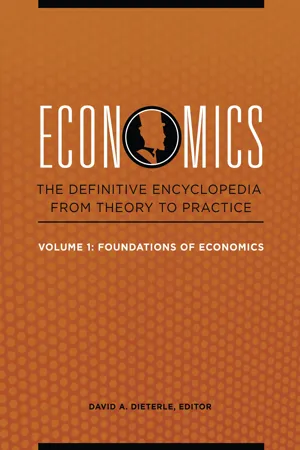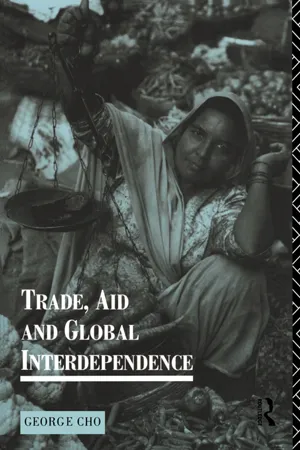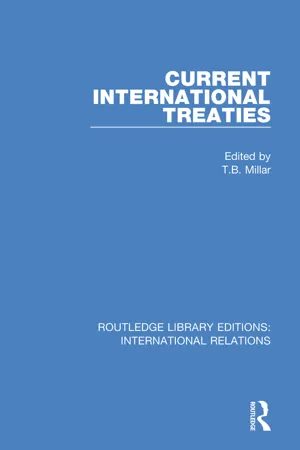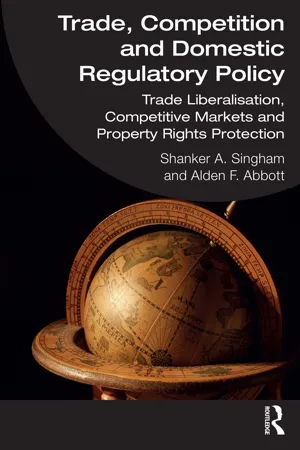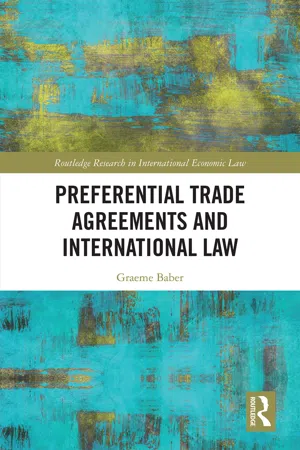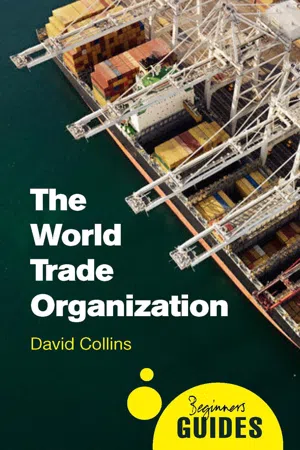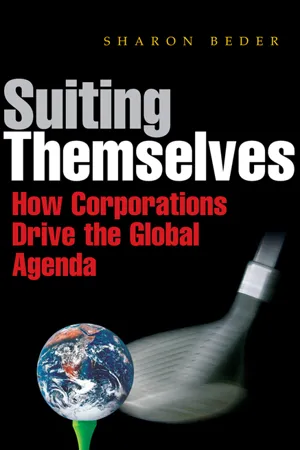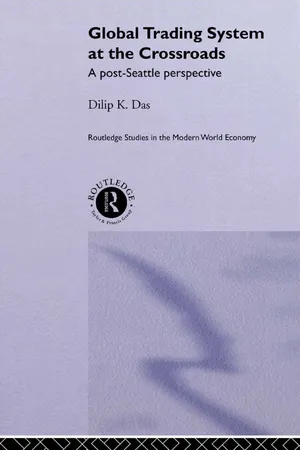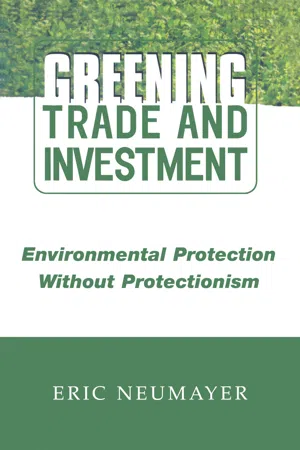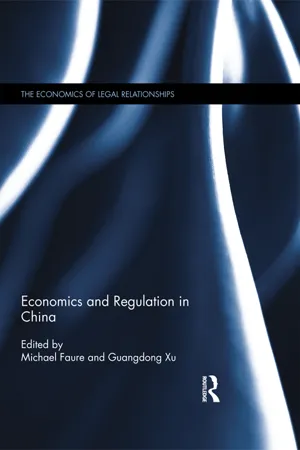Economics
General Agreement on Tariffs and Trade (GATT)
The General Agreement on Tariffs and Trade (GATT) was a multilateral trade agreement that aimed to reduce barriers to international trade and promote economic cooperation among member countries. It was established in 1947 and served as a framework for negotiating trade agreements and resolving disputes. GATT played a significant role in shaping global trade policies and was eventually replaced by the World Trade Organization (WTO) in 1995.
Written by Perlego with AI-assistance
Related key terms
Related key terms
1 of 4
Related key terms
1 of 3
12 Key excerpts on "General Agreement on Tariffs and Trade (GATT)"
- eBook - ePub
- A. I. MacBean, P. N. Snowden(Authors)
- 2021(Publication Date)
- Routledge(Publisher)
The General Agreement on Tariffs and Trade (GATT)The main objectives of the GATT are the reduction of tariffs, the prohibition of quantitative restrictions and other non-tariff barriers to trade and the elimination of trade discrimination. In addition Part IV of the agreement, added in 1965, extended these objectives in the interests of the less developed countries to include efforts to stabilise commodity prices and to give better access to the markets of the developed countries for exports from developing countries.The purpose of this chapter is to evaluate the GATTs contribution towards attainment of these objectives and, more broadly, to consider the GATT’s overall contribution to world economic welfare in the past and its potential contribution in the near future. The world economy has changed in many ways since the inception of the GATT. The key question is whether the GATT remains relevant or not.The GATT Approach
The GATT fulfils several functions. It provides:- a set of agreed rules to govern trade between nations;
- rules and procedures to facilitate and discipline negotiations between nations on trade and commerce;
- a forum for international multilateral negotiations on trade as well as for the day-to-day bilateral negotiations and conciliation meetings which form a large part of the normal work of the GATT;
- a small but highly skilled and experienced secretariat which can assist in all these matters through research and documentation of the issue and by the exercise of leadership and diplomacy.
Rules
The General Agreement is a very complex, detailed and technical document which sets out the rules for the conduct of trade between the members and the many exceptions to these rules which political necessity requires. However, three rules and their exceptions are of particular importance. The first is the rule against discrimination in imports or exports. This is the most favoured nation (MFN) clause of the agreement which we quoted in Chapter 1 - eBook - ePub
Economics
The Definitive Encyclopedia from Theory to Practice [4 volumes]
- David A. Dieterle(Author)
- 2017(Publication Date)
- Greenwood(Publisher)
GGENERAL AGREEMENT ON TARIFFS AND TRADEThe General Agreement on Tariffs and Trade (GATT) was a multilateral agreement that established rules for international trade from 1948 to 1994. The overriding goal of GATT was to promote free trade among nations. In 1947, 23 countries met in Geneva, Switzerland, to negotiate the first set of trade rules and tariff reductions. The result of these initial trade negotiations was the General Agreement on Tariffs and Trade. GATT, which took effect on January 1, 1948, consisted of 45,000 tariff concessions. History refers the 1947 negotiations as the first GATT trade round. From 1948 to 1994, four directors-general led GATT: Sir Eric Wyndham-White (1948–1968), Olivier Long (1968–1980), Arthur Dunkel (1980–1993), and Peter Sutherland (1993–1994).GATT’s 23 founding countries, headed by the United States and the United Kingdom, assumed that GATT would soon be absorbed into a new International Trade Organization (ITO)—an institution that was also under negotiations during the late 1940s. The ITO was intended to be the third pillar of the Bretton Woods System, joining the newly formed World Bank and International Monetary Fund (IMF) in maintaining an orderly and prosperous post–World War II global economy. Negotiations to create the ITO stalled at the Bretton Woods Conference in July 1944 but continued in a series of conferences in London, Geneva, and, finally, Havana, Cuba. In 1948 delegates from 54 countries signed the Havana Charter, also called the ITO Charter. By the late 1940s, however, interest in yet another multilateral organization had waned in some industrialized countries, most notably the United States. The U.S. Congress shelved the Havana Charter in 1950. Without U.S. participation, plans for the ITO were abandoned.Multilateral trade negotiations continued despite the collapse of the proposed ITO. The original GATT agreement became a rallying point for non-Communist countries that supported trade expansion as a means of achieving economic growth and development. Under the auspices of GATT, a series of eight multilateral trade negotiations took place from 1947 to 1994. Multilateral trade negotiations were called trade rounds. Early trade rounds concentrated on reducing tariffs on merchandise. A tariff is a tax on an imported good. Tariffs discourage imports by raising their price. Later trade rounds, especially the Tokyo Round and the Uruguay Round, expanded trade negotiations to reduce trade barriers on merchandise and services. Later trade rounds also responded to changes in the global economy. The Uruguay Round (1986–1994) involved 123 nations. The Uruguay Round tackled issues related to tariff and non-tariff trade barriers, subsidies, dumping, trade in services, intellectual property rights, and other issues in the global trading system. - eBook - ePub
- George Cho(Author)
- 2008(Publication Date)
- Routledge(Publisher)
• Transparency. This ensures that traders are not handicapped because of a lack of information on regulations or taxation. Also a stable and predictable basis for trade is provided by the ‘binding’ of the tariff levels negotiated among the contracting parties. When a country becomes a GATT member, it agrees to fix its tariffs which can only be raised if compensation is negotiated under special terms.• Consultation, conciliation and dispute settlement are fundamental to the work of the GATT. • A country may, when its economic or trade circumstances warrant it, seek exemption from certain GATT obligations. • There is a general prohibition on the use of quantitative restrictions, for example, import quotas, except when a country’s balance of payments so warrants.• The GATT permits the establishment of regional trading arrangements such as the EU or US-Canada Free Trade Agreement provided certain criteria are met. The criteria are meant to ensure that such trade arrangements do not raise barriers to world trade (Searing 1992: 101–3).The way in which these principles are set in place is through a series of multilateral trade negotiations. Since 1947 eight rounds of trade negotiations have taken place (see Figure 5.3 ).Figure 5.3 The GATT and trade negotiation roundsWhile the early rounds of negotiations achieved reductions in tariffs on thousands of goods the Tokyo Round went substantially beyond traditional negotiations that eliminated tariffs and quotas. The Tokyo Round covered eight areas of contention: - eBook - ePub
- T B Millar(Author)
- 2015(Publication Date)
- Routledge(Publisher)
The Agreement was aimed at abolishing quotas and reducing tariffs on a bilateral basis between member states, who are bound by the most-favoured-nation principle and the concept of consultation to avoid damage to the trading interests of the parties. It has proved the most effective single instrument in liberalizing world trade, despite escape clauses and many exceptions to prevent 'excessive damage' through trade losses. Most UN members, including some of the Soviet bloc but not the USSR itself, are parties to the Agreement.Only some of the key articles are included.General Agreement on Tariffs and Trade (GATT) *
[Preambular paragraphs omitted.]Part I
Article I General most-favoured-nation treatment
1. With respect to customs duties and charges of any kind imposed on or in connnection with importation or exportation or imposed on the international transfer of payments for imports or exports, and with respect to the method of levying such duties and charges, and with respect to all rules and formalities in connection with importation and exportation, and with respect to all matters referred to in paragraphs 2 and 4 of Article III,† any advantage, favour, privilege or immunity granted by any contracting party to any product originating in or destined for any other country shall be accorded immediately and unconditionally to the like product originating in or destined for the territories of all other contracting parties.2. The provisions of paragraph 1 of this Article shall not require the elimination of any preferences in respect of import duties or charges which do not exceed the levels provided for in paragraph 4 of this Article and which fall within the following descriptions: - eBook - ePub
The WTO
Crisis and the Governance of Global Trade
- Rorden Wilkinson(Author)
- 2013(Publication Date)
- Routledge(Publisher)
The chapter begins with the first trade negotiations held under GATT auspices and ends with the financial and commercial crisis that developed in the wake of the Kennedy round (1964–1967). It focuses on the use of the GATT to facilitate post-war recovery and the growing problems of agricultural protectionism, non-tariff barriers, trade in primary commodities, and textiles and clothing. It also explores growing pressure to amend the General Agreement to take account of the specific needs of developing countries, the challenge to the GATT posed by the creation of an alternative trade institution in the form of the UN Conference on Trade and Development (UNCTAD), and the tensions that emerged during and after the conclusion of the Kennedy round. The chapter draws to a close with a summary of the argument developed thus far.Deploying the GATT
The emergence and subsequent consolidation of a culture of informality (detailed in the previous chapter) was just one of the GATT’s emerging defects. More troubling was the emerging asymmetry of opportunity arising from the way in which the General Agreement was deployed as an instrument of liberalisation. From the outset, the GATT evolved as an industrial nations club. Its original design as a mechanism for facilitating trade-led US growth and Allied reconstruction ensured that the GATT was better suited to enhancing the economic opportunities of its industrial contracting parties than the primary, agricultural and textile producing economies of their developing counterparts. As Tigani Ibrahim recalled, the GATT served ‘to govern the conduct of the major trading countries in: (a) their trade with each other; (b) their competition with each other in third countries; and (c) the way in which third countries could behave towards their major trading powers in relation to that competition’ (Ibrahim, 1978 : 25). It was inevitable, then, that the liberalisation conducted under GATT auspices would target those areas best suited to these ends (see Wells, 1969 - eBook - ePub
Trade, Competition and Domestic Regulatory Policy
Trade Liberalisation, Competitive Markets and Property Rights Protection
- Shanker A. Singham, Alden F. Abbott(Authors)
- 2023(Publication Date)
- Routledge(Publisher)
6 THE GENERAL AGREEMENT ON TARIFFS AND TRADE A Temporary Fix but a Constitutional Foundation DOI: 10.4324/9780429323331-6 As was discussed above, the GATT agreement represented the compromise solution to the critical failure of the ITO at the hands of the US Congress. GATT consisted of what was intended to be a temporary agreement, pending the successful ratification of the ITO. Few at the time thought that the ITO’s successor’s ratification would take another five decades. The GATT is therefore a contract between a group of countries. It is founded on two fundamental principles, the principle of Most Favoured Nation and the principle of National Treatment. We briefly introduced the two central themes of the GATT in the first chapter. We will now discuss these themes in greater detail, as well as the rule excepting regional trade agreements from general MFN requirements. These two themes are extremely important in WTO law as they represent the constitutional architecture of the global trading system. We discussed the MFN and National Treatment principles in Chapter 2. These are the fundamental building blocks of the WTO. As noted previously, there are exceptions to the MFN principle. A strict application of the MFN principle would mean that no WTO member could embark on separate negotiations to form either more regionally limited free trade areas (“RTAs”), or customs unions (CUs). Article I itself accommodates the trade preferences that existed prior to 10 April 1947. However, RTAs are subject to GATT provisions, specifically Article XXIV. In the last 30 years, there has been an explosion of Free Trade Agreements, coinciding with a slowdown in the pace of global trade negotiations. There are now over 500 free trade areas (FTAs), all of which are technically subject to Article XXIV - Graeme Baber(Author)
- 2018(Publication Date)
- Routledge(Publisher)
1 The World Trade Organization’s International Trade Agreements – The General Agreement on Tariffs and Trade Structure and CommentaryOn 15 April 1994, the Parties to the Agreement Establishing the World Trade Organization decided to found the WTO1 . The Annexes to that Agreement contained 13 Multilateral Agreements on Trade in Goods (including the GATT2 ) – one of which expired on 1 January 20053 , the GATS4 , the TRIPS5 , the DSU6 , the TPRM7 and the four Plurilateral Trade Agreements8 – two of which are no longer in force9 . On 22 February 2017, a further Multilateral Agreement on Trade in Goods – the Agreement on Trade Facilitation – was added to Annex 1A to the Agreement Establishing the World Trade Organization, and came into force on that date10 .The GATT
The GATT comprises its predecessor, GATT 194711 – subject to minor modifications12 – and the following additional documents: (i) identified protocols and decisions that came into force prior to the date on which the Agreement Establishing the World Trade Organization became effective13 , (ii) six specified Understandings14 , and (iii) the Marrakesh Protocol15 . Reference to Articles in the GATT in this book are to the updated version of GATT 1947 – although these only refer to ‘GATT’, as they also apply under the 1994 Agreement.Article I: General Most-Favoured-Nation Treatment
Article I:1: The MFN Rule
Article I:1 of the GATT provides that, in respect of issues concerning importation, exportation or the cross-border transfer of payments with regard to imports or exports, any favourable treatment that a Member of the WTO provides to another state in respect of any product originating in or in transit to the latter is to be instantly and unconditionally granted to the same product that was produced in or destined for the territory of any other Member16 . This is known as the MFN Rule, as it requires MFN treatment to be extended to all Members of the WTO17 . Article I:1 of the GATT is intended to prevent discrimination between similar products that originate in, or are destined for, different jurisdictions18 . Accordingly, this Article applies to measures that appear to be ‘origin-neutral’ but which make it possible for discrimination to be made in practice19 . Furthermore, the application of MFN treatment in part only – to some products but not others and/or with regard to some but not all Members of the WTO, is a breach of Article I:1 of the GATT – which specifies any advantage, product and Member20- eBook - ePub
The World Trade Organization
A Beginner's Guide
- David Collins(Author)
- 2015(Publication Date)
- Oneworld Publications(Publisher)
4 Playing fair: non-tariff barriers to tradeThe GATT, and the WTO after it, were immensely successful in reducing tariffs, which had been the chief barrier to trade in the twentieth century. But the attachment in many countries to protectionism – safeguarding the interests of the domestic economy, meaning firms and workers – remained. Structuring laws to favour local over foreign goods is probably as politically important in the twenty-first century as it has ever been, despite the widespread endorsement of free trade ideology by economists, diplomats and policymakers the world over.The success of tariff negotiations, coupled with the non-discrimination guarantees of most favoured nation and national treatment, accordingly led to new challenges for politicians who wanted to help their own producers. The WTO’s increasing membership sought creative ways to favour their own goods, in conjunction with sticking to GATT rules on tariff bindings and agnosticism with respect to a product’s origin. In particular, the unfair trade practices of subsidization and dumping have now become the most readily used weapons in the arsenal of the trade protectionist. Recognizing the danger of these key policy tools, the WTO realized that it needed to expand its mandate to address these types of trade-distorting practices. Drafted in the 1940s, the GATT rules on subsidies and dumping were inadequate for the modern era, so the WTO created two dedicated agreements to address these highly popular and contentious fields of national economic policy. We will look at both of them in this chapter.Subsidization
If you cannot make foreign products more expensive because tariffs have been essentially eliminated, then why not make domestic ones cheaper? As long as the local product is less expensive than the equivalent foreign one, it doesn’t matter how this is achieved, at least from the perspective of protecting your own producers. This strategy – helping domestic firms keep their costs low so that they can make their products cheaper – is known as subsidization. - eBook - ePub
Suiting Themselves
How Corporations Drive the Global Agenda
- Sharon Beder(Author)
- 2012(Publication Date)
- Routledge(Publisher)
49 The US government approved GATT, and in early 1995 the WTO was set up to administer GATT.UNDERMINING DEMOCRATIC OBJECTIVESAccording to Adam Smith’s metaphor of the invisible hand, the whole of society benefits from private companies doing business freely in the marketplace; government regulations can only interfere with this.50 The alternative view, not recognized by free trade proponents, is that government regulations are necessary to ensure that business activity is, indeed, in the interests of the majority. Without such regulations, transnational companies are free to accumulate market power and exercise it to avoid competition and maximize profits at the expense of consumers, small companies and developing economies.Given the thousands of pages of rules that the WTO now presides over, ‘free’ trade is not about doing away with rules altogether, but rather replacing rules for companies with rules for governments, and replacing rules that protect citizens, consumers and the environment with rules that protect and facilitate traders and investors.From the late 1960s, the GATT Secretariat, though it was unconstitutional and temporary, had become ‘the most powerful, entrenched non-organization the world had seen’. Today, the WTO has greater powers than any other international institution, including powers to punish non-complying nations that are not even available to the United Nations. Over 130 nations are now members of the WTO. It has become a form of global government in its own right with judicial, legislative and executive powers:51. . . the WTO has come to rival the International Monetary Fund as the most powerful, secretive and anti-democratic international body on Earth. It is rapidly assuming the mantle of a bona fide global government for the ‘free trade era,’ and it actively seeks to broaden its powers and reach. - eBook - ePub
- Dilip K. Das(Author)
- 2001(Publication Date)
- Routledge(Publisher)
8 What is important now is the distribution of the gains rather than their aggregate scale.At the dawn of the twenty-first century, however, the global trading system finds itself at a crossroads. The reason is that free trade has rarely been a popular cause. The brief history of the international trading system presents numerous glaring examples of this. Several compromises had to be made in the creation of the GATT. During the 1960s and the early 1970s, industrial economies increasingly adopted trade liberalization. The GATT provided them with a framework for a co-ordinated multilateral liberalization of trade. Successive GATT rounds of MTNs helped in reducing tariffs. In contrast, developing economies over this period shunned liberalization and pursued inward-looking strategies. In their endeavors to modernize their economies, they adopted “infant industry” support of nascent industries, as well as “import substitution” for the development of domestic industry. As a part of this inward-looking strategy, tariffs, quotas, and exchange payment restrictions in many developing countries were increased. Generally, domestic political opposition blocks liberalization moves. Entrenched interests fight hard, and frequently with prolonged success, to maintain their protected positions.Although GATT’s success during the early 1960s was well admired, by the early 1970s it was moribund. The Tokyo Round of multilateral trade negotiations, launched by the large trading economies in 1973 with the intention of achieving substantial tariff cuts, was erratic and protracted. In the mid-1980s, leading trade experts thought that the GATT was “in a state of breakdown” (Das, 1990). The Uruguay Round of MTNs, which was launched in September 1986, seemed doomed to failure as the European Union (EU) and the United States found themselves locked in a politically complex struggle over agricultural pricing and subsidies. It did collapse and had to be pulled back to its feet by the extraordinary perseverance and diplomatic skills of Arthur Dunkel, the erstwhile Director General of the GATT. International trade continues to be an important area of policy debate for both developing and industrial economies. - eBook - ePub
Greening Trade and Investment
Environmental Protection Without Protectionism
- Eric Neumayer(Author)
- 2017(Publication Date)
- Routledge(Publisher)
2 The Current Multilateral Trade and Investment Regimes Trade and the environment The agreement establishing the WTO and the GATT The preamble The preambular language to the GATT 1947 leaves readers in no doubt why environmentalists, especially those who are pessimistic about the environmental effects of economic growth, are suspicious towards the General Agreement on Tariffs and Trade. In the preamble the GATT parties state their desire to strive for, among other things, ‘a large and steadily growing volume of real income and effective demand, developing the full use of the resources of the world and expanding the production and exchange of goods’ (emphasis added). The rhetoric of this quotation is one of ‘frontier economics’ (Colby 1991), for which limitless economic growth is both possible and desirable, and environmental constraints are non-existent. Of course, such a rhetoric might not be surprising, given the time at which the GATT was negotiated. When almost 50 years later countries concluded negotiations on the Agreement Establishing the World Trade Organization, in its preamble the ‘full use of the resources of the world’ had given way to ‘the optimal use of the world’s resources in accordance with the objective of sustainable development’ (emphasis added). Furthermore, the World Trade Organization (WTO) parties assured that they were ‘seeking both to protect and preserve the environment and to enhance the means for doing so in a manner consistent with their respective needs and concerns at different levels of economic development’ - eBook - ePub
- Michael Faure, Guangdong Xu(Authors)
- 2013(Publication Date)
- Routledge(Publisher)
25 Finally, we discuss that a multilateral institution such as the GATT can better enable countries to enforce trade agreements. As mentioned above, how can an international agreement be self-enforcing?When considering the GATT enforcement and the repeated games, given the assumed symmetry across countries, for a fixed cooperative tariff τc <τN , if the domestic government deviates and selects τ ≠ τc , then it will deviate to its best-response τN . Ω(τc ) characterizes the short-term incentive that a government has to cheat. The short-term benefit includes two components.26 One part is the welfare impact of the deviation through the change in the local price, which is negative. The other part is the welfare impact of the deviation through the change in the terms of trade. It is positive, as it reflects the welfare gain to the government from the transfer of income to itself from its trading partner. As showed in Figure 9.3 , the sum of these two terms Ω(τc ) is zero at τc = τN and strictly positive for τc < τN .The long-term cost of the retaliation is losing the value to the domestic government of avoiding a trade war and sustaining the cooperative tariff. V(τc ) is defined as the total discounted value to cooperation that the domestic government forfeits when it cheats.27 As showed in Figure 9.3 , it follows that V(τc ) > 0 for τc < τN , while V(τc ) = 0 for τc < τN .Therefore, the domestic government’s incentive constraint can be written asAny cooperative tariff τc satisfied in Equation (9.1) can be enforced as the sub-game perfect equilibrium of the repeated tariff game. The smallest tariff satisfies the incentive constraint, regarded as the ‘most-cooperative’ tariff, .In Figure 9.3 , Ω(τc) is monotonically decreasing in τc for τc < τN , while Ω(τc) is flat and equal to zero at τc = τN . Intuitively, a government gains less in deviating from a cooperative tariff τc the closer is that tariff to the Nash tariff τN , and the government gains nothing from cheating when the cooperative tariff is already at the Nash level. Also, V(τc) is zero a τC= τN , monotonically decreasing in τc for τc < τPO ,28 and flat at τc = τPO . Therefore, the gains from avoiding a trade war decline to zero as the tariffs stipulated in the agreement rise from τPO
Index pages curate the most relevant extracts from our library of academic textbooks. They’ve been created using an in-house natural language model (NLM), each adding context and meaning to key research topics.
Explore more topic indexes
Explore more topic indexes
1 of 6
Explore more topic indexes
1 of 4

